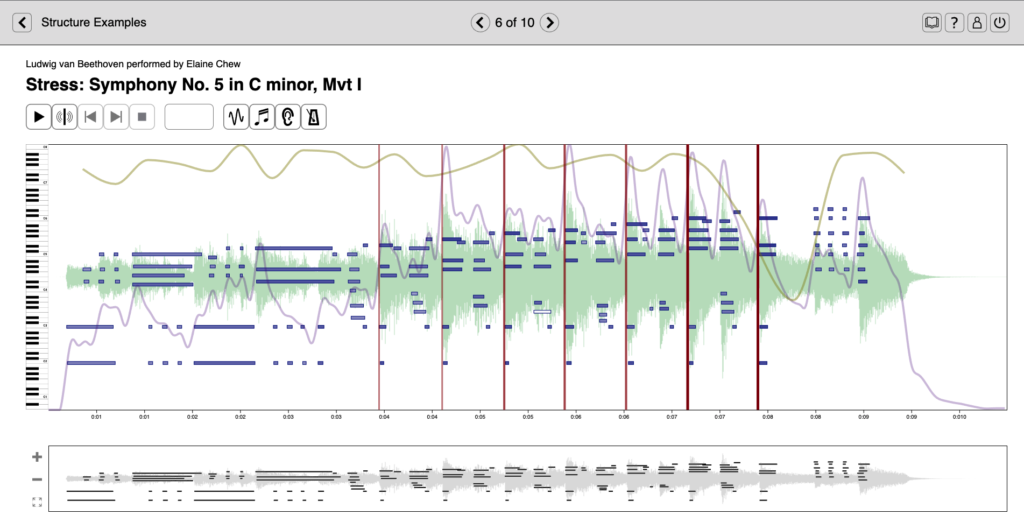Software engineer: Lawrence Fyfe
Doctoral researcher: Daniel Bedoya
The CosmoNote citizen science platform (cosmonote.isd.kcl.ac.uk) was designed as the listening, visualisation, and annotation platform for understanding and discovering musical structure in performed (expressive) music that result from acoustic variations introduced by musicians during musical performance. CosmoNote is a central result of the ERC COSMOS project (PI: E Chew, cosmos.isd.kcl.ac.uk).

CosmoNote’s collections are largely based on music audio and MIDI data collected on the COSMOS project’s Bösendorfer Disklavier (Enspire PRO) and features extracted automatically using our cosmodoit software developed by Corentin Guichaoua and Daniel Bedoya. See the video report for Le Monde.
The performed music information layers CosmoNote visualises include tempo, loudness, harmonic tension, and the annotation tools include boundaries, regions, note groups, and comments. Here, research software engineer Lawrence Fyfe describes CosmoNote’s tools and functions.
Fyfe, L., D. Bedoya, E. Chew (2022). Annotation and Analysis of Recorded Piano Performances on the Web. Journal of the Audio Engineering Society, 70(11): 962–978. doi: 10.17743/jaes.2022.0057 .
Everyone can create an account to explore CosmoNote’s collections.
Tutorials : Annotating Music
CosmoNote is designed to enlist volunteer thinking to mark up and explain expressive music structures. Here are some tutorials and examples developed by doctoral student Daniel Bedoya (Sorbonne Université PhD thesis completed October 2023).
How to Use CosmoNote
Annotated Musical Prosody Examples
More Examples: Segmentation and Prominence
More Examples from Chopin’s Ballade No. 2
Tutorials : Annotating ECG
CosmoNote can concurrently display physiological time series that are linked to the music data. Here is an example of concurrent ECG and music information where the music was deliberately composed to mirror the ECG’s abnormal rhythms.
Music of Arrhythmia
Annotating ECGs
Chew, E, M Orini, P Lambiase (2021). Putting (One’s) Heart Into Music. Cardiopulse, European Heart Journal, 42(28): 2721-2724. doi:10.1093/eurheartj/ehab108. doi.org/10.1093/eurheartj/ehab108 (On 15 Dec 2021: among top 10 downloaded articles, with nearly 2500 downloads)
Coming Soon
In the ERC POC HeartFM project (PI: E Chew, heartfm.kcl.ac.uk), we collect concurrent music and physiological information from performers and listeners and use CosmoNote to test hypotheses underpinning the causes of individual responses to music. See Falling Walls Breakthrough of the Year Award.
Chew, E, P Loui, G Leslie, C Palmer, J Berger, E Large, NF Bernardi, S Hanser, JF Thayer, MA Casey, PL Lambiase (2021). How Music Can Literally Heal the Heart. Medicine | Opinion, Scientific American, 18 Sep. bit.ly/sciam-muscheart
A next development goal for CosmoNote is to integrate it with PhysioNet (the Research Resource for Complex Physiologic Signals) and to make it a visualisation option for all of PhysioNet’s databases, which are managed by the MIT Laboratory for Computational Physiology.